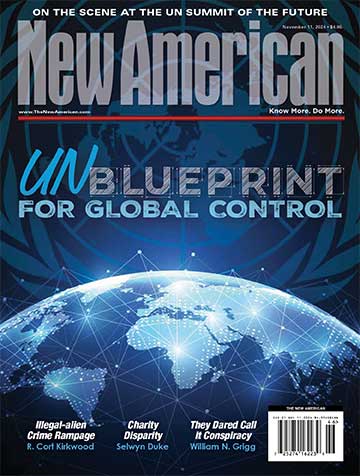
New Rochelle, N.Y. — Living right next to New Rochelle, I was certainly struck when I heard it was the epicenter of Wuhan-virus infection in the United States. More than 100 of our nation’s at least 1,663 cases are in the small city of almost 80,000 people, the result of a congregant inadvertently infecting others at the Young Israel of New Rochelle synagogue earlier this month. That man, a lawyer who works near Grand Central Station in Manhattan, is currently hospitalized.
The outbreak prompted officials to create the nation’s first “containment area,” in New Rochelle, a suburb approximately eight miles from the New York City border. What this means is that since Thursday (yesterday), houses of worship, schools, and other places used for large gatherings have been closed, in accordance with an announcement Governor Andrew Cuomo made earlier this week. Moreover, the “National Guard will be deployed to clean public areas within the containment area and deliver food to homes,” reports CNN. “And a satellite testing facility will be set up in partnership with Northwell Health.”
{modulepos inner_text_ad}
“People are allowed to move freely within the zone and outside it, Cuomo said. ‘But no large gatherings, because the large gatherings are where it spreads,’” the site continued.
I visited a supermarket (Shoprite) in New Rochelle a few days ago and found business and activity there apparently normal. Unfortunately, this isn’t the case everywhere — and may not be at that Shoprite now. So with people reacting and over-reacting, some perspective is in order.
The Centers for Disease Control (CDC) reports that most people contracting the Wuhan virus will have mild symptoms or none at all. Yet as with the flu, it can be deadly to those in high-risk groups, such as the elderly and individuals with underlying health problems.
So who are the unfortunates who’ve died, and where were they? As journalist Sharyl Attkisson reported March 12:
The majority of U.S. deaths to date (31 of 40) have occurred among the elderly, sick in Washington State nursing homes or long term care facilities.
A majority of the Washington State deaths (27 of 31) occurred in King County.
A majority of the King County deaths in Washington State (22 of 31) occurred at the same elderly nursing facility in Kirkland. This large cluster in one facility is under investigation.
There have also been three deaths in Snohmish [sic] County, and one in Grant County (Washington State).
There have been four deaths among the elderly in California.
There have been two deaths among the elderly in Florida.
Three deaths have been reported among elderly, sick men in New Jersey, South Dakota, and Georgia.
The average age of the deceased is 80, with no reports of anyone 50 or younger dying from Wuhan virus.
Note that in Italy, which has been hard hit by the disease, the picture is the same: Half the deceased are over 80. Note that while the overall Wuhan-virus mortality rate may be less than one percent, it may be eight percent among those over 70, and 15 percent among those over 80.
Again, though, it has long been likewise with the flu. As Healthline reports, “From 70 to 85 percent of all flu-related deaths, and 50 to 70 percent of flu-related hospitalizations, occur among those 65 years and over, according to the CDC.”
In fact, many call the flu “an even deadlier virus” — and for good reason: It has killed tens of thousands yearly, including 61,000 during the 2017-2018 season alone. The Wuhan virus pales in comparison, thus far.
Nonetheless, we’re still in the grip of a media-driven panic. I visited two other Westchester (the county New Rochelle is in) supermarkets Thursday, and the crowds were almost prohibitive. And hand sanitizer and rubbing alcohol are sold out everywhere.
This is both good and bad. On one hand, people are discovering better hygiene practices; on the other, they’re often discovering them wrongly.
In one supermarket, I saw a man diligently spray sanitizer on his hands in the middle of an aisle. I find this now-common scene amusing because I’ve carried sanitizer with me for many years; the micro-organism threat didn’t start with Wuhan virus, after all. And that man probably could have waited until he was done shopping.
In another local supermarket, there was a woman wearing medical gloves (which seemed dirty), one of which she used to rub her nose. Of course, you can infect yourself with a gloved hand just as easily as with a bare one.
As to what measures we should take, below is a short video of Fox News medical contributor Dr. Marc Siegel providing advice on avoiding infection. Note that most of his prescriptions apply anytime you’re out and about.
Then, bearing in mind that all disease transmission is behaviorally influenced, the following should be common practice whether a pandemic looms or not:
• Keep hand sanitizer on you and use it whenever you’re out and about, making contact with objects many others have touched.
• Clean and disinfect regularly touched objects in your home or workplace when a pandemic threatens.
• Avoid shaking hands when a pandemic threatens.
• Don’t touch your eyes, nose, or mouth with unsterilized hands. Clean them with soap and water or sanitizer first.
• If possible, stay home when you’re sick; if you must go out, consider wearing a mask to avoid infecting others. In the least, sneeze and cough into a tissue (then discard it) or, at worst, into your upper arm’s shirtsleeve. Also, don’t forget to wash your hands and use sanitizer frequently when you’re ill to minimize the chances of spreading disease.
So people are frantic about Wuhan virus. But the real tragedy here is what’s missed: If we regularly practiced the above, many if not most of the tens of thousands of yearly flu deaths could be avoided. We could literally save lives. So the moral of this story is that the panic should end — the prudence should not.
Photo: AlxeyPnferov / iStock / Getty Images Plus
Selwyn Duke (@SelwynDuke) has written for The New American for more than a decade. He has also written for The Hill, Observer, The American Conservative, WorldNetDaily, American Thinker, and many other print and online publications. In addition, he has contributed to college textbooks published by Gale-Cengage Learning, has appeared on television, and is a frequent guest on radio.



